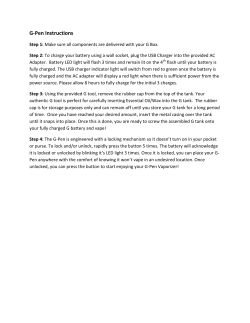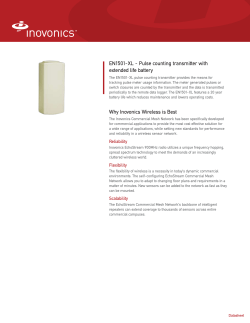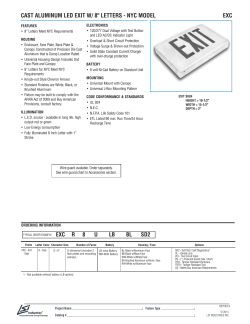
Instruction manual PSV 2465-12 24 VDC/6.5 A
24 VDC/6.5 A Battery 12 Ah/Security grade 3 Power Supplies Instruction manual PSV 2465-12 DESCRIPTION MAIN FEATURES PSV 2465-12 is an up-to date power supply unit with battery backup compliant with EN. Unit provides all features required by EN 50131-6:2008, security grade 3. Security grade 3 (EN 50131-6:2008) Type A – mains supply with rechargeable battery Total rated output in grade 3: 0.25 A (30 h in battery mode with 12 Ah batteries) Total rated output in grade 2: 0.74 A (12 h in battery mode with 12 Ah batteries) Total rated maximal output to installation: 6.0 A Battery recharging current – 0.5 A, providing recharging time below 24 h Total current capacity of power unit – 27.6V, 6.5 A ViP (Voltage-in-Parallel) feature increasing reliability and capacity of power supply systems – power supplies with ViP feature can be connected in parallel to same bus without need for additional synchronization Capable to work with pack of two 12 V/12 Ah sealed lead acid batteries Short circuit and overload protection Detection of no mains supply (EPS fault) Detection of different battery faults (APS fault) – not connected, low voltage, high internal resistance Detection of low output voltage (OUT fault) Detection and LED identification of broken fuses Detection of power unit failure Deep discharge protection of battery (DDP) Remote and local battery testing Tamper security provided – case opening and pry-off Distinctive and unique feature of PSV 2465-12 is invented by Alarmtech ViP mode – Voltage-in-Parallel. Power supply units with ViP feature can be connected in parallel both (+) and (-) on one common power bus without a need of additional synchronization. Connected units will share load on a bus. ViP feature can be used to build distributed and redundant power systems. It can be also used to compensate voltage drops on a bus by placing power supply units in distant bus sections. Power conversion is based on high frequency SMPS regulator providing high conversion efficiency. Low losses inside unit preserve batteries from overheating shortening battery life time. Computerized battery recharging circuit works in constant potential – limited current mode – the best mode to provide the longest possible battery life time. Power unit is equipped with built-in diagnostic system detecting and signalling mains failure, different battery failures including end-of-life warning, output faults like low voltage or broken fuse. APPLICATIONS Power supply system for 24 V installations Distributed power supply systems with built-in redundancy Power supply systems for access control, fire and intruder alarm installations BLOCK DIAGRAM 230 VAC _ + Power Supply 24 VDC L PE N EPS – External Power Supply (mains) APS – Alternative Power Source (battery) OUT - Output voltage SAB – Sabotage SDT – Storage Device (battery) Test © 2014 Alarmtech Power unit PSV 2465 230 VAC input Front panel OUT + 24 VDC Output OUT ViP output BAT + BAT - Signalling outputs EPS, APS, OUT, SAB Fault signalling outputs 1/4 SDT input Remote battery test 12 V battery 12 Ah 12 V battery 12 Ah Battery pack 2x 12 V/12 Ah PSV 2465-12 manual 14165en 1. INSTALLATION Case fixing hole Case fixing hole Power Unit PSV 2465 Mains fuse: 2.5 A slow Mains connector Battery fuse: 10 A quick PSV-2465 A larm tech V iP P ower Supply F1: T2.5H250V F2: F6.3H250V F3: F10H250V To display panel N L PE Case earthing point To earting connector in lid F3 Battery recharg . current = 0.5 A F1 SDT EP S AP S OUT SA B SA B -SDT* N L Tamper detector F2 +BAT- VOUT COM Power output 24 V I/O cables Tamper detector + + - Case fixing hole Case fixing hole PSV 2465-12 power supply installation and start-up procedure: Fix unit in destination place using 4 fixing holes Place two sealed lead acid batteries 12 V/ 12 Ah in battery chambers Make internal connection in battery pack connecting left battery (-) with right battery (+) Make connection between right battery (-) and battery connector using black battery cable connected to BAT Make connection between left battery (+) and battery connector using red battery cable connected to +BAT Make appropriate connections between power output and power receivers Make required connections between signalling outputs of PSV ©2014 Alarmtech KI CKSTA RT Signalling outputs Mains cable entry Battery chamber for 2 sealed lead acid batteries 12 V/12 Ah Output fuse: 6.3 A quick 2/4 2465-12 unit and cooperating units (outputs EPS, APS, OUT, SAB, input –SDT*) The socket outlet delivering 230 VAC shall be installed near the power supply unit and shall be easily accessible Make sure that cable delivering 230 VAC to power supply is disconnected from mains Carry in cable delivering 230 VAC to the unit using separate mains cable entry on the left side and connect it to 230 VAC input of PSV 2465 power unit – make sure that PE cable is connected to PE input Switch on mains delivering energy to power supply - PSV 2465-12 unit will start automatically delivering power to the load and monitoring state of PS PSV 2465-12 1416en 2. TECHNICAL DESCRIPTION 2.1 Front panel Power supply unit is equipped with front panel showing actual general state of unit. Three LED’s display shows: Green LED: mains voltage present – unit in EPS mode supplied from mains Yellow LED: mains voltage missing – unit in APS mode supplied from battery Red LED: fault detected – quick visual identification and localisation of failure is possible with help of set of diagnostic LED’s in power unit 230 VAC _ + Power Supply 24 VDC Power Supply 24 VDC Power Supply 24 VDC Power Supply 24 VDC Unit state OK Supplied from mains Battery OK Output OK No faults reported 230 VAC _ + 230 VAC _ + 230 VAC _ + Missing mains (EPS output triggered) Supplied from battery No other faults PS supplied from mains Possible fault detected: - APS (battery) - OUT (output) Missing mains (EPS output triggered) Supplied from battery Possible faults detected: - APS (battery) - OUT (output) 2.2 Internal state monitoring functions in power units All monitored states of PS are displayed with help of LED diodes for quick visual identification. The placement of monitoring LED is documented in below placed drawings. The meaning of LED colours is following: Green normal state, OK Red fault detected Yellow informative meaning (neutral) LED red: EPS fault LED red: APS fault Output fuse, 6.3 A quick Battery fuse, 10 A quick LED red: OUT fault Alarmtech ViP PSV-2465 Power Supply F1: T2.5H250V F2: F6.3H250V F3: F10H250V N L F3 Battery recharg. current = 0.5 A F1 SDT EPS APS OUT SAB SAB -SDT* F2 KICKSTART +BAT- VOUT COM Input AC voltage Input fuse, 2.5 A slow EPS fault output (isolated) APS fault output (isolated) OUT fault output (isolated) Kick start shunt Tamper fault output To tamper switches Storage Device Test ground (-) Storage Device Test input (*) ©2014 Alarmtech 3/4 LED green: output voltage OK Output 24 V 24 V battery pack recharging LED yellow: battery recharging enabled Front panel / USB link Open: battery circuit enabled Closed: battery circuit disabled Closed-to-open: battery test triggered PSV 2465-12 1416en 2.3 Jumpers in power units Power unit is equipped with 2 jumpers placed on PCB: Kick-start jumper (default position: open) Momentary shunt Kick-start of PS from battery (w/o mains) Open (default) Deep Discharge Protection (DDP) of battery enabled Closed Deep Discharge Protection (DDP) of battery disabled SDT (Storage Device Test) jumper (default position: open) Momentary shunt Battery test trigger (30s test of internal battery circuit resistance) Open (default) Battery recharging circuit enabled Closed Battery recharging circuit disabled 2.4 Input/output terminals Input / Output Mains input with PE Mains failure signalling Battery failure signalling Output failure signalling SAB Tamper output/input Storage Device Test trigger Battery pack connection Power output Marking PE, N. L EPS APS OUT SAB, SAB -SDT* +BATVOUT COM Description 230 VAC input Potential free NC opto-relay output signalling EPS fault Potential free NC opto-relay output signalling APS fault Potential free NC opto-relay output signalling OUT fault Potential free NC micro-switch connection points Test triggered by momentary shunt between (-) and (*) (+) and (-) terminals for 2x12 V battery pack connection (+) and (-) terminals for power output 3. TECHNICAL SPECIFICATION Type of Power Supply acc. to EN 50131-6:2008: Security grade acc. to EN 50131-6:2006: Nominal input voltage rating: Nominal output voltage: Minimum output voltage in battery mode: Total rated output in grade 3: Total rated output in grade 2: Total maximal output to installation: Quiescent current consumed by built-in modules in PS: Maximum output ripple voltage: Battery pack type: Battery recharging method: Maximum battery recharging current: Time to recharge batteries to 80%: Over-voltage protection trigger level: Battery pack voltage triggering APS fault: Battery pack voltage triggering DDP circuit: Output voltage triggering OUTPUT fault: Monitoring outputs: Electrical characteristics of monitoring outputs: Logical characteristics of monitoring signals: Remote battery test input: Remote battery test acknowledgement: Local battery test trigger: Automatic battery diagnostics procedure: Operating temperature and humidity range: Environmental Class acc. to EN 50130-5:1998: Weight without batteries: Weight with batteries: Dimensions: Compliance: ©2014 Alarmtech type A grade 3 230 VAC, 1.25 A with maximal load, 50 Hz 27.6 V 20.0 V (in APS mode) 0.25 A (30 h in APS mode with 12 Ah batteries) 0.74 A (12 h in APS mode with 12 Ah batteries) 6.0 A 0.06 A < 50 mVpp two 12 V/12 Ah sealed lead acid batteries in series constant potential – limited current 0.5 A 24 h max 34.5 V 22 V 19 V (Deep Discharge Protection level) 18 V EPS – loss of mains APS – battery pack low voltage, battery failure, disconnected OUT – output voltage low, power unit failure SAB – case tampering - opto-isolated semiconductor relay for EPS, APS, OUT - micro-switch for case tampering SAB closed state – monitored condition not present open state – monitored condition present -SDT* - shunt between terminals (-) and (*) triggers 30 s test APS output SDT jumper, momentary shunt executed every 10 h automatically -10 ºC…+55 ºC, RH to 90%, no condensation class II approx. 3.3 kg approx. 11.4 kg 345 x 325 x 130 mm (W x H x D) 4/4 PSV 2465-12 1416en
© Copyright 2025









